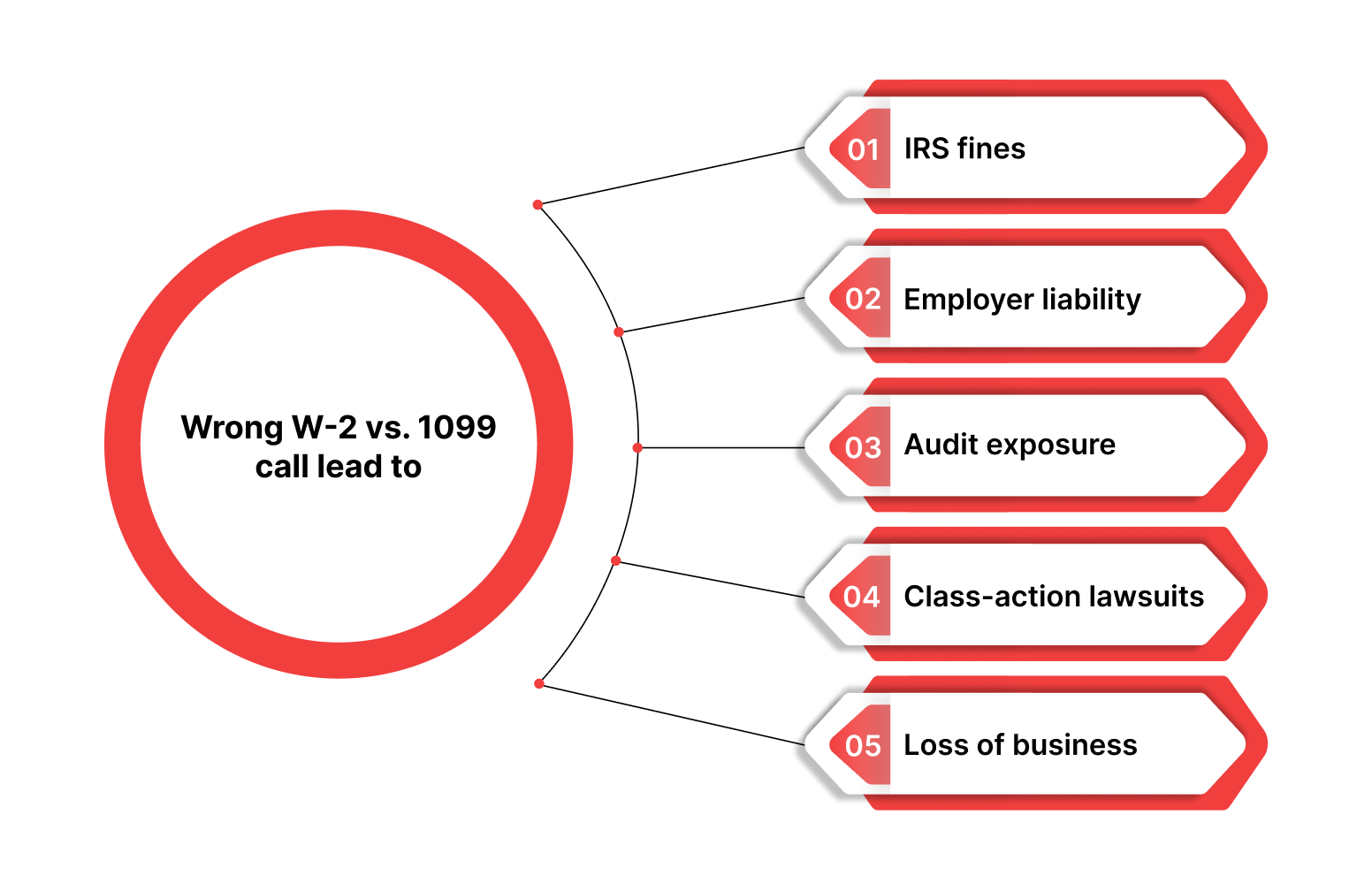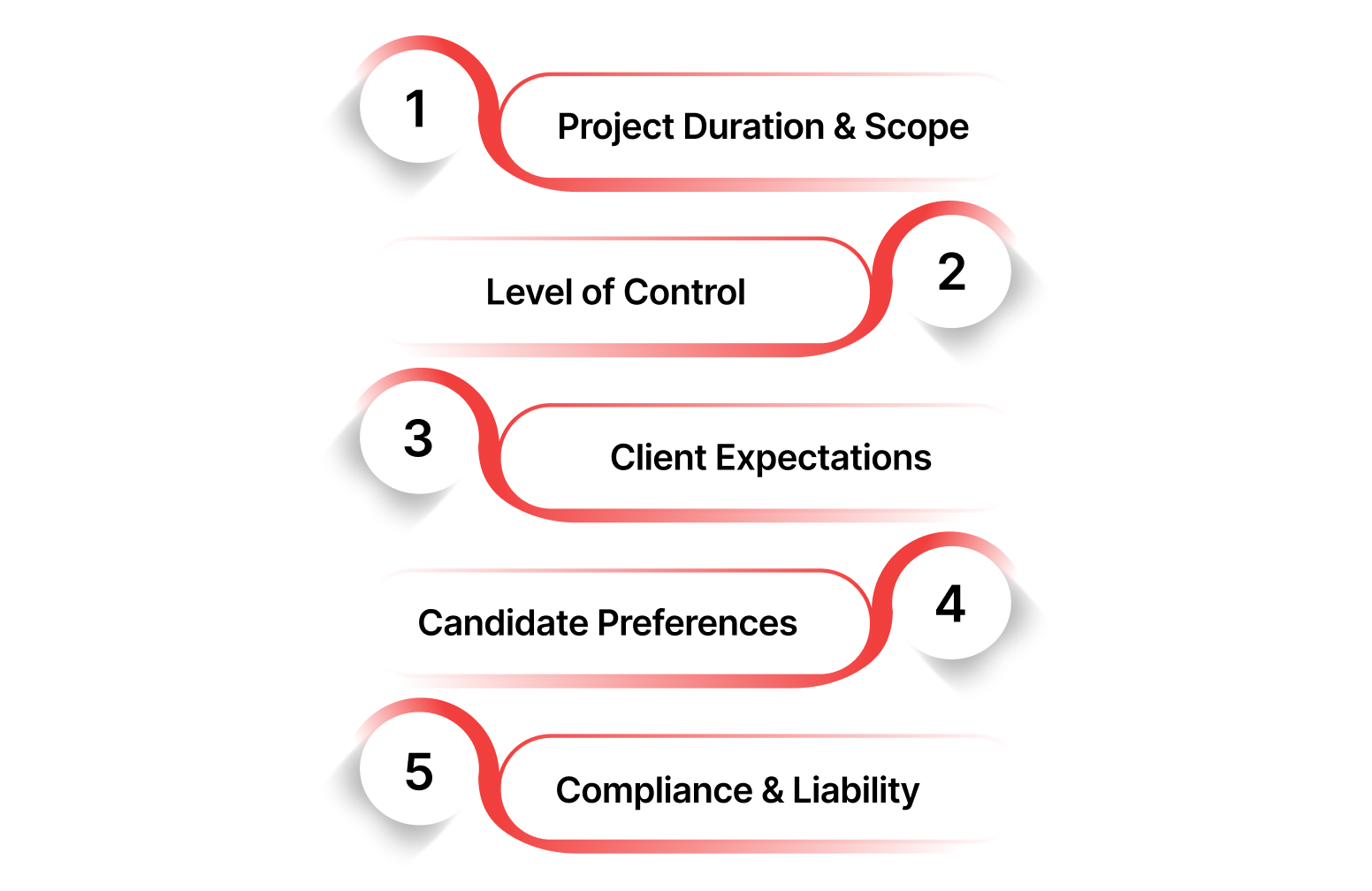You finally find the right candidate that’s skilled, available, and ready to move.
Then comes the question: “Will they be W-2 or 1099?”
For account managers, this isn’t just red tape. The classification affects payroll, compliance, taxes, and your relationship with the client.
Get it wrong, and you could face back-and-forth emails, legal risk, or worse, client distrust.
Get it right, and everything runs smoother: faster onboarding, fewer issues, and peace of mind for everyone involved.
In this article, we break down what W-2 and 1099 really mean and why understanding the difference matters more than ever.
TL;DR
- W-2 workers require tax withholdings, benefits, and labor law protections—ideal for long-term roles with client oversight.
- 1099 contractors offer flexibility and cost savings, but come with audit risk if used where the client controls work, tools, or schedule.
- States apply stricter rules, making misclassification a legal and financial minefield.
- Staffing teams must align classification with project needs, client expectations, and candidate preferences to avoid risk and ensure lasting placements.
Understanding W-2 and 1099 Employment
When speed matters and compliance is critical, knowing how to classify talent becomes non-negotiable.
A wrong call here isn’t just an admin error; it’s a financial and legal liability waiting to happen.
Let’s understand the two classifications that shape every staffing decision.
W-2 Employment: Structured, Secure, and Company-Led
W-2 workers are considered employees. They’re on payroll and tied to your client’s business structure.
Key traits of W-2 employment:
- Employer withholds and pays taxes
- Eligible for benefits like insurance and PTO
- Protected by labor laws and wage standards
These workers often follow a fixed schedule, use company tools, and report to company leadership.
1099 Employment: Flexible, Independent, and Project-Based
1099 workers are self-employed. They control how, when, and where the work gets done.
Key traits of 1099 employment:
- Responsible for their own taxes
- Not entitled to benefits or protections
- Use their own tools and systems
These workers take on short-term assignments and often juggle multiple clients.
The table below is a quick comparison of W2 vs 1099:
Remember, the clearer the classification, the smoother the placement and the lower the compliance risk.
At Consultadd, we specialize in C2C (Corp-to-Corp) placements, offering the flexibility of 1099 with the structure and compliance benefits clients often expect from W-2 setups. By delivering pre-vetted, ready-to-work professionals, we help staffing firms avoid hiring delays, reduce risk, and maintain high candidate quality without the usual administrative burden.
Employment Relationships
Every hire is more than a reW-2 Employment: Structured, Secure, and Company-Ledsume match; it’s a relationship with legal and financial consequences.
Therefore, correct classification protects your business and builds trust.
Here’s what defines the difference.
W-2: The Employer-Employee Relationship
A W-2 worker has a structured, ongoing relationship with the hiring company.
Key characteristics:
- The company directs when, where, and how work is done
- The relationship is typically long-term or indefinite
- Workers are entitled to benefits and protections under labor laws
This model offers more control but also comes with greater responsibility for compliance.
1099: The Independent Contractor Relationship
A 1099 contractor has a business-to-business relationship with the hiring organization.
Key characteristics:
- Contractors control their own hours, methods, and work processes
- The arrangement is often project-based or time-limited
- They don’t receive benefits, overtime, or workplace protections
This model offers flexibility, but it can expose businesses to legal risk if misused.
W2 vs 1099: How They Compare
Tax Implications
Taxes aren't just numbers on a spreadsheet; they can make or break your staffing margins.
One mistake can mean audits, delays, and broken trust.
Let’s look at how W-2 and 1099 impact tax responsibilities differently.
W-2: Employer-Supported Tax Handling
With W-2 employees, the employer shoulders most of the tax administration burden.
Employers are responsible for:
- Withholding income taxes
- Paying Social Security and Medicare contributions (50%)
- Handling unemployment and workers’ compensation taxes
Employees receive:
- A W-2 form at year-end
- Regular paychecks with taxes already deducted
This model is higher-effort, but it reduces audit risks and supports long-term compliance.
1099: Self-Managed Tax Responsibility
1099 contractors manage their own taxes. This lowers employer burden but increases classification risk.
Contractors must:
- File self-employment taxes
- Pay full Social Security and Medicare contributions
- Report earnings via Form 1099-NEC
Employers are only responsible for issuing a 1099 form if payments exceed $600.
Before diving into tax details, ensure the candidate is legally eligible to work. Read: What Is a Work Authorization? Explained.
Benefits and Compensation
A strong compensation package can turn hesitation into commitment and benefits, beyond pay, and shape how candidates view the role and employer.
Here’s how W-2 and 1099 differ when it comes to perks and pay.
W-2: Structured, Secure, and Sticky
W-2 roles offer more than a paycheck; they create a sense of belonging and safety.
Typical W-2 benefits include:
- Health, dental, and vision insurance
- Paid time off and sick leave
- Retirement plans (401(k), pensions)
- Bonuses and overtime pay
This model helps attract cautious candidates looking for stability and long-term growth.
It also boosts retention, reducing the constant cycle of sourcing and rehiring.
1099: Flexible Pay, Fewer Benefits
Contractors often earn higher hourly rates, but benefits are rarely included.
Most 1099 roles do not offer:
- Health insurance
- PTO or holidays
- Employer-sponsored retirement plans
Instead, 1099s get flexibility in how, when, and where they work.
But freedom often trades off consistency; better offers mean they move on.
Benefits Breakdown: At a Glance
Compliance Pitfalls: Penalties, Lawsuits, and State-Level Surprises
Misclassifying a worker isn’t just a paperwork error; it can unravel client trust, trigger legal action, and result in hefty financial penalties.
What’s at Stake?
A wrong W-2 vs. 1099 call could lead to:

- IRS fines (e.g., $50 per unfiled W-2, plus interest and back taxes)
- Employer liability for unpaid Social Security and Medicare taxes
- Audit exposure that disrupts operations and damages credibility
- Class-action lawsuits (especially common in states like California and New York)
- Loss of business if clients view your agency as a compliance risk
Why State Rules Matter
Some states, like California (ABC test), apply stricter rules than federal guidelines. That means a contractor in one state might legally need to be a W-2 employee in another.
That’s why compliance shouldn’t be left to guesswork.
For a deeper look at proper worker classification, read: Classifying Employees the Right Way: A Compliance Guide.
Implications for Candidates and Clients
Hiring isn’t just a business transaction; it’s a ripple effect that shapes lives and impacts reputations.
Each classification choice (W-2 or 1099) comes with trade-offs, not just for workers, but for the companies hiring them.
For Candidates: Security vs. Independence
Job seekers today are more informed, cautious, and selective.
They’re asking: “Will this role support my long-term goals or just cover my bills?”
W-2 pros:
- Predictable income and benefits
- Protection through labor laws
- Eligibility for unemployment and workers’ compensation
W-2 cons:
- Less control over the schedule
- Taxes withheld from each paycheck
1099 pros:
- Greater freedom and earning potential
- Ability to juggle multiple clients
1099 cons:
- No employer-sponsored safety net
- Higher risk, especially during economic dips
Some candidates thrive with autonomy. Others need structure to perform at their best.
For Clients: Risk, Loyalty, and Legal Fallout
The decision isn’t just about payroll costs, it’s about stability, culture, and risk exposure.
W-2 workers offer:
- Stronger loyalty
- Easier integration into teams
- More control over hours, training, and tasks
But they also mean:
- More paperwork and upfront costs
- Compliance with federal and state employment laws
1099 contractors bring:
- Cost savings on benefits and taxes
- Short-term agility for project-based work
But also come with:
- Higher turnover risk
- Potential penalties for worker misclassification
Missteps here don’t just hurt your budget; they can derail your client relationships and credibility.
Partner with Consultadd to eliminate compliance guesswork.
We handle all documentation, including visas, payroll, 401(k), benefits, and insurance, while delivering candidates who meet strict state and federal requirements.
Factors to Consider When Choosing Between W-2 and 1099

Every role is different. Every client has unique expectations.
Choosing between a W-2 or 1099 hire isn’t just administrative, it’s strategic.
1. Project Duration and Scope
- Short-term and project-based roles? 1099 contractors are preferred.
- Longer engagements with set hours? W-2 makes more sense.
Misaligned contracts frustrate clients and increase attrition.
2. Level of Control
- Need to manage hours, tools, or processes? That’s a W-2 requirement.
- Is the worker self-directed with niche expertise? Then 1099 may be suitable.
Control is a legal trigger. Missteps here could cost thousands in penalties.
3. Client Expectations
Clients want peace of mind, especially with high-visibility roles.
- Some demand a W-2 for tighter accountability.
- Others prefer 1099 to reduce overhead.
Understanding their risk appetite helps you recommend the right model.
4. Candidate Preferences
Skilled professionals know their worth and how they want to work.
- Some won’t touch 1099 roles due to a lack of benefits.
- Others chase 1099 flexibility and tax advantages.
Know what makes top talent say “yes” and stick around.
5. Compliance and Liability
Misclassifying workers is one of the fastest ways to lose trust.
- W-2 requires withholding, unemployment, and proper documentation.
- 1099 puts the burden on the worker, but the liability still loops back to you.
When in doubt, err on the side of caution and compliance.
The right choice isn’t always easy. But when it aligns with the job, the client, and the talent, it works.
Conclusion: W-2 vs 1099 Isn’t Just a Model, It’s a Business Decision
As a hiring manager, you don’t just place candidates; you protect client timelines, reduce risk, and shape long-term business outcomes.
Choosing between W-2 and 1099 goes beyond classification. It’s about control, compliance, and the quality you stand behind.
That’s where Consultadd steps in, not just to fill a role, but to future-proof your hiring strategy.
We ensure:
- Safe, reliable hires: Each candidate is thoroughly vetted for experience, compliance, and readiness from day one.
- Lower turnover risks: Our professionals stay committed, no disappearing acts, no last-minute drop-offs.
- Seamless compliance: Visa paperwork? Regulatory updates? We handle it all, so you don’t have to.
- Ongoing support: Post-placement, we’re still in the game, making sure hires grow with your clients.
Backed by:
- 14+ years in business
- 5,000+ successful staffing engagements
- ~65 happy staffing firms onboarded just last year
- MSAs with industry leaders like Teksystems and Robert Half
- Top 100 candidates sourced within the last year alone
- 1:1 account managers who understand your goals and urgency
- Ready-to-deploy talent, often sourced in under 24 hours
- And strong university partnerships to support fresh, emerging talent pipelines
W-2 or 1099, whatever the model, you deserve a partner who treats your urgency like their own.
Consultadd is that partner.
Let’s talk about how we can help you staff smarter, faster, and with confidence.
FAQs
1. What is the biggest tax difference between a W-2 and a 1099?
W-2 employees have taxes withheld and split with the employer, including Social Security and Medicare. 1099 contractors pay self-employment tax, covering the full 15.3% for Social Security and Medicare themselves.
2. What is the difference between a W-2 and a 1099 in California?
California uses the strict ABC test to classify workers. Most roles with client control over work must be W-2. Misclassifying a 1099 contractor under these conditions can result in penalties and back taxes.
3. Which is best, W-2 or 1099?
W-2 is best for long-term roles needing oversight, benefits, and compliance. 1099 suits short-term, independent projects. The right choice depends on work scope, control, and legal requirements, not preference alone.

.jpeg)